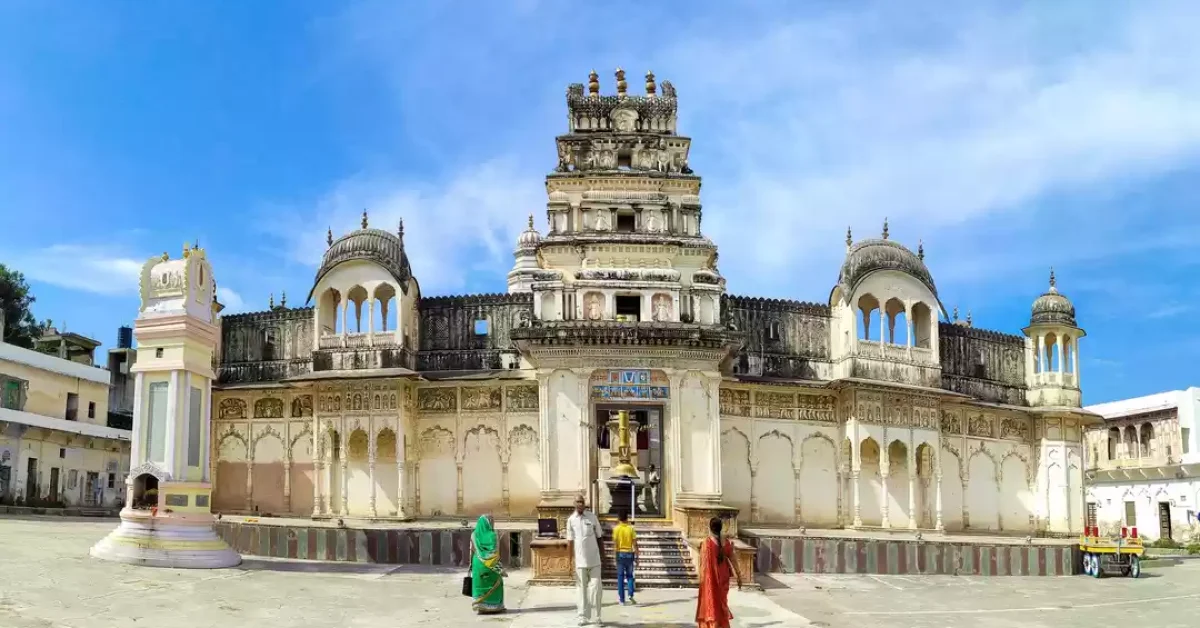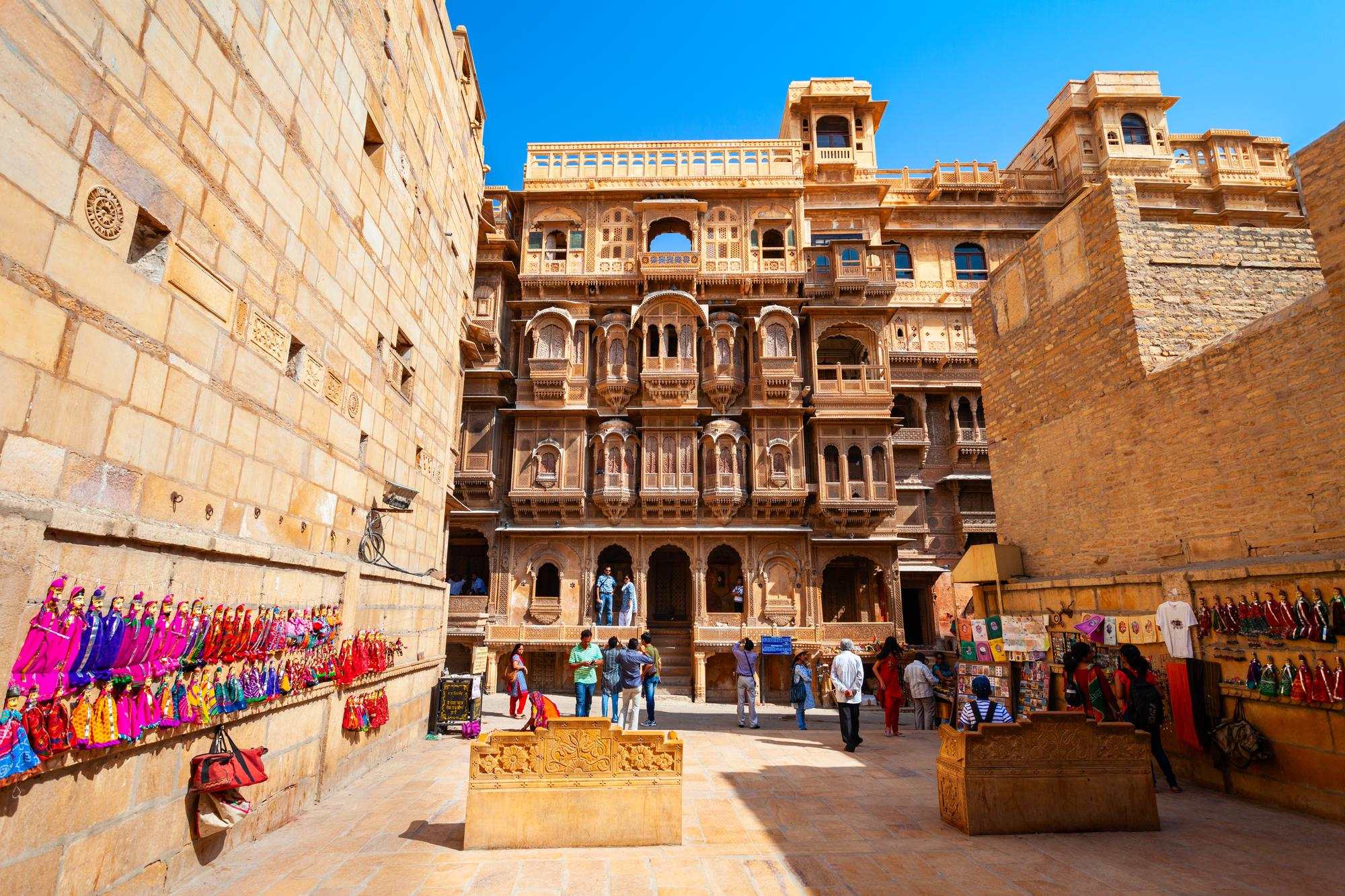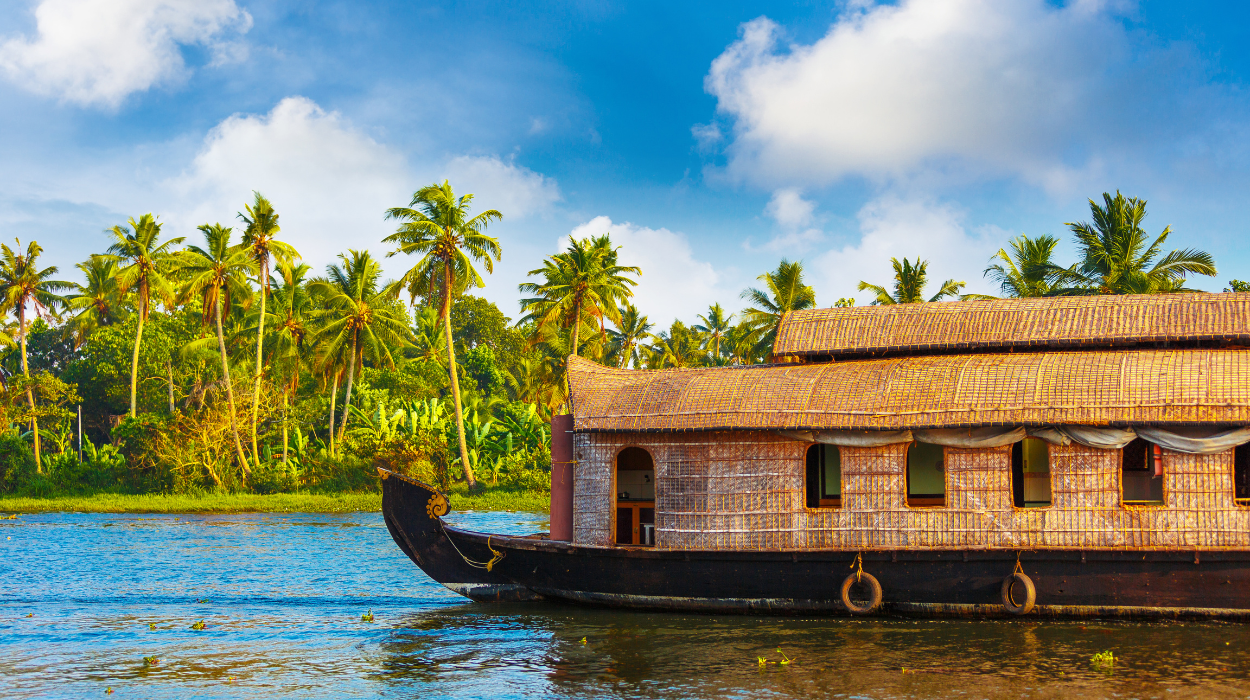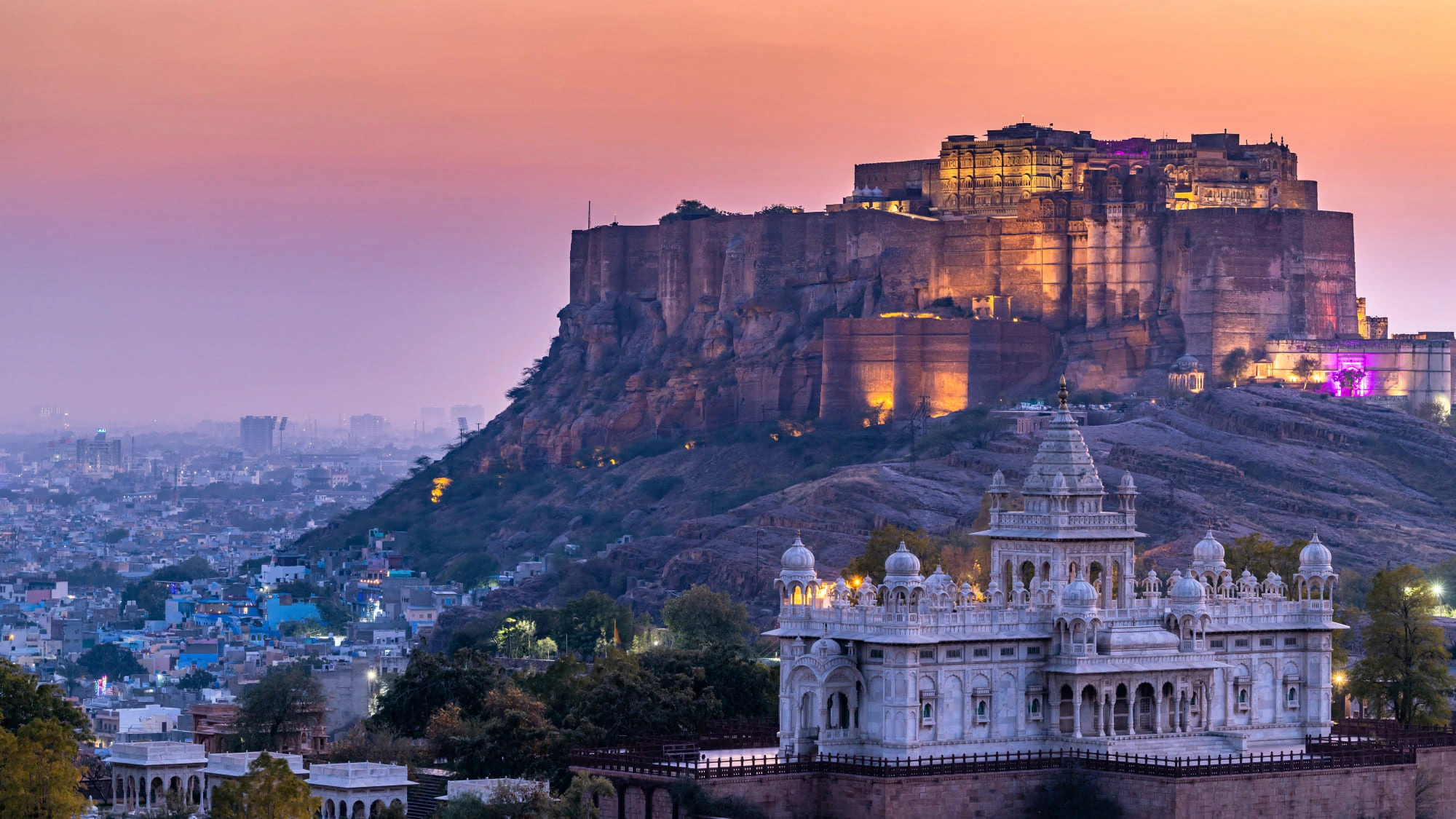About Brahma Temple – The Only Brahma Mandir in India
The Brahma Temple in Pushkar, often referred to as the only temple dedicated to Lord Brahma in India, holds immense religious and historical value. Nestled beside the sacred Pushkar Lake, this iconic shrine is one of the most revered Pushkar mandirs, drawing thousands of pilgrims and spiritual seekers every year.
Importance of Brahma Mandir in India
Unlike other Hindu deities who have countless temples across the country, Lord Brahma, the creator in the Hindu trinity, has very few temples dedicated to Him. The Brahma Temple Pushkar stands out as the most prominent and sacred one. For devout Hindus, visiting this temple is a rare spiritual opportunity to worship the creator directly—something that isn’t commonly accessible elsewhere in India.
Mythological Significance and Story
According to Hindu mythology, Lord Brahma performed a yajna (sacred ritual) at the spot where the temple now stands. To complete the yajna, He created Pushkar Lake and married a local girl, Gayatri, due to the absence of His wife Savitri. Enraged, Goddess Savitri cursed Brahma that He would be worshipped only in Pushkar, which is why the Brahma Temple in Pushkar remains uniquely significant. This legend is deeply rooted in the spiritual narrative of Pushkar ji temple and enhances its divine aura.
Unique Architecture and Red Stone Construction
Built with red sandstone and marble, the temple’s architecture is both simple and striking. The Shikhara (spire) is beautifully adorned with a hamsa (swan) motif—Lord Brahma’s mount—and the sanctum houses the four-faced idol of Brahma along with Gayatri. The distinctive red shikhara of the Brahma Mandir Pushkar can be seen from afar, making it a key landmark in the city’s skyline. The ancient structure is said to date back to the 14th century, although the current version has undergone several restorations over time.
Historical and Religious Significance of Pushkar Mandir
The Pushkar Mandir, especially the Brahma Temple, is deeply intertwined with the spiritual essence of Pushkar town. As one of the oldest living cities in India, Pushkar is mentioned in various Hindu scriptures and epics, making it a pivotal center for Hindu pilgrimage. The sanctity of this temple is magnified by its proximity to Pushkar Lake, which is believed to have been created by Lord Brahma himself.
Connection with Pushkar Lake
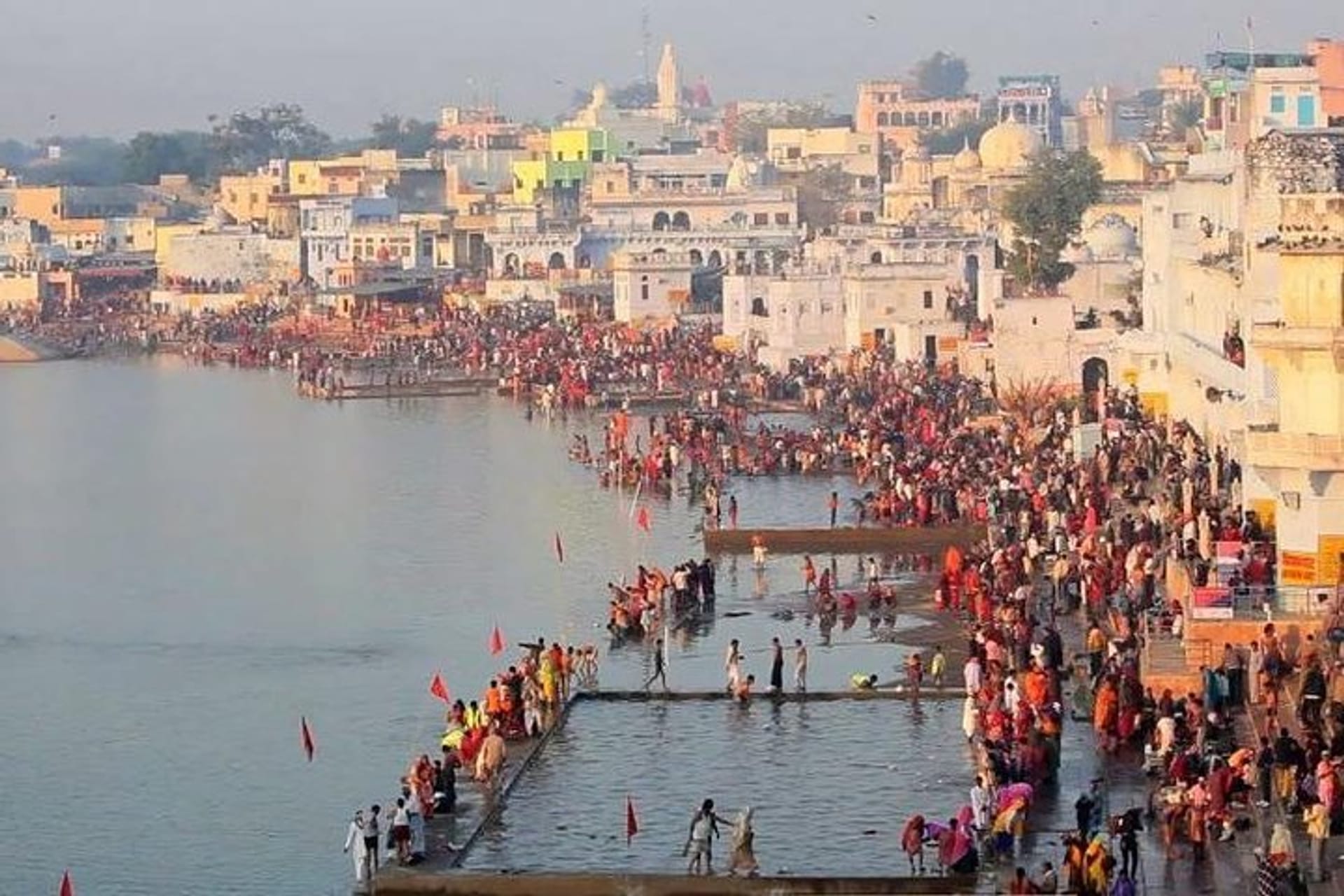
According to legend, when a demon tried to disrupt Brahma’s yajna, the Lord struck him down with a lotus flower. The petals of that lotus are said to have fallen at three places, one of which created the sacred Pushkar Lake. This lake is not only a beautiful natural attraction but also one of the five most sacred pilgrimage sites for Hindus—collectively known as the “Panch Sarovar.” Devotees believe that taking a holy dip in this lake washes away sins and leads to salvation, which is why it plays a vital role in Pushkar Mandir’s religious significance.
Why Pushkar Is Sacred for Hindus
Pushkar holds the rare distinction of being the only place where Lord Brahma is worshipped with full rituals. Pilgrims from across India and abroad visit this Pushkar ji temple to seek blessings, especially during the Kartik Purnima festival, when thousands gather to perform rituals around the lake and temple. The town is also home to over 400 temples and 52 ghats, making it a miniature spiritual universe. The combination of mythological relevance, holy water, and temple presence makes Pushkar a sacred tirtha (pilgrimage site).
Quotes from Scriptures or Saints
The Padma Purana, one of the most revered Hindu texts, states:
“Among all the tirthas, Pushkar is the holiest; one who bathes in Pushkar Lake and worships Brahma attains moksha.”Adi Shankaracharya, the 8th-century philosopher and saint, is believed to have acknowledged Pushkar as a center of intense spiritual energy and included it in the sacred geography of India.
A common local belief says:
“Pushkar mein Brahma, sab tirthon ka mahamela,”
meaning “In Pushkar resides Brahma, and it is the grand confluence of all pilgrimages.”
Brahma Temple Pushkar Timings (Darshan & Entry Hours)
Planning your visit to the sacred Brahma Temple Pushkar requires knowing the correct darshan timings to ensure you don’t miss the serene and spiritually enriching experience. The temple is open to devotees every day, offering both morning and evening darshan sessions. Understanding the Pushkar temple timings helps visitors align their visit with the temple’s rituals and aarti ceremonies.
Morning and Evening Darshan Timings
Morning Darshan: 6:00 AM to 1:30 PM
Evening Darshan: 3:00 PM to 9:00 PM
These Brahma Temple Pushkar timings remain consistent throughout the week, allowing devotees ample time to explore the premises, participate in rituals, and sit for a moment of spiritual reflection. It is recommended to arrive early during the morning session for a quieter and more peaceful experience.
Seasonal Variations (Summer/Winter If Any)
Although the official darshan hours usually remain the same, there can be minor adjustments during extreme seasons:
In summer months (April to June), evening darshan might extend slightly beyond 9:00 PM due to longer daylight hours.
In winter (November to February), the temple may close slightly earlier in the evening due to cooler temperatures and fewer visitors.
However, these changes are usually communicated locally, and temple staff ensures visitors are informed well in advance.
Public Holidays or Special Schedules
The temple remains open on all major Hindu festivals, including Kartik Purnima, Diwali, and Pushkar Mela, when special rituals and extended darshan hours are often observed. On such occasions, Pushkar temple timings are adjusted to accommodate large crowds, and a special aarti is conducted in the presence of thousands of devotees.
If you’re planning a visit during festivals or religious events, it’s advisable to check with the official local tourism office or your hotel for updated timings and crowd control measures.
Brahma Temple Pushkar Aarti Timings
The Brahma Temple Pushkar aarti timings are among the most sacred aspects of a devotee’s visit. These ritualistic prayer ceremonies, conducted with chants, bells, incense, and oil lamps, create a powerful spiritual ambiance that leaves a lasting impression on pilgrims and tourists alike.
Morning Aarti Schedule
Morning Aarti: 6:00 AM – 6:30 AM
The morning aarti at Brahma Temple begins just after sunrise. It is a calm, soulful experience that marks the beginning of the temple’s daily rituals. Devotees gather to offer prayers and witness the priests chant Vedic mantras while lighting lamps before the deity. The early morning light and the peaceful atmosphere near Pushkar Lake make this an unforgettable spiritual moment.
Evening Aarti and Rituals
Evening Aarti: 7:00 PM – 7:30 PM
The evening aarti is another significant spiritual ceremony held at sunset. During this time, the temple is lit with dozens of diyas (oil lamps), and devotional hymns fill the air. It marks the closing rituals of the day and draws a large number of pilgrims. The Brahma Temple Pushkar aarti timings in the evening align beautifully with the golden hour, making it a photographer’s and pilgrim’s delight.
Best Time to Attend for Devotee
The best time to attend the aarti at Brahma Temple Pushkar is during the early morning session if you’re seeking peace and fewer crowds. However, the evening aarti is more vibrant and visually stunning, making it ideal for those who want to witness the temple’s divine energy in full bloom.
To fully immerse in the spiritual essence of Pushkar, many devotees attend both morning and evening aartis, especially during auspicious days like Kartik Purnima or the Pushkar Camel Fair, when special extended aarti sessions are conducted.
Book, Now:- Golden Triangle Tour with Pushkar Camel Fair 2025
What to Expect During Your Visit to Pushkar Ji Temple
Visiting the Pushkar Ji Temple, especially the Brahma Mandir Pushkar, is more than just a religious journey—it’s a deeply immersive cultural and spiritual experience. From the moment you step into the serene temple town of Pushkar, you’ll feel a shift in energy that resonates through its sacred ghats, ancient shrines, and peaceful lake.
Entry Fees (If Any)
There is no entry fee to visit the Brahma Temple Pushkar, making it accessible to all. Devotees and tourists are welcome to explore the premises, participate in the rituals, and seek blessings without any cost. However, donations are accepted near the sanctum for temple maintenance and religious ceremonies.
Dress Code and Visitor Rules
Visitors are expected to wear modest and respectful clothing, covering shoulders and knees.
Footwear is not allowed inside the temple premises.
Photography inside the sanctum sanctorum is strictly prohibited, although you may capture the exteriors respectfully.
Silence and decorum must be maintained throughout the temple complex.
These guidelines reflect the sacredness of the Pushkar mandir and ensure that all visitors can enjoy a respectful and tranquil experience.
Mobile/Camera Restrictions
While mobile phones are allowed, visitors are encouraged to switch them to silent mode. Photography is not allowed inside the inner sanctum of the Brahma Temple. Professional camera equipment may be restricted without prior permission. It’s best to inquire at the temple gate if you’re carrying any large recording devices.
A visit to this revered brahma mandir pushkar offers moments of silence, introspection, and spiritual clarity. Whether you come as a pilgrim or a curious traveler, the temple and its surroundings promise a deep connection to India’s rich spiritual heritage.
What to Expect During Your Visit to Pushkar Ji Temple
A visit to the Pushkar Ji Temple, especially the revered Pushkar Mandir dedicated to Lord Brahma, is a spiritually fulfilling experience. Whether you’re a pilgrim or a first-time visitor, knowing what to expect can enhance your visit and help you prepare accordingly.
Entry Fees (If Any)
There is no entry fee to visit the Pushkar Ji Temple. The temple remains open to all visitors throughout the year. While entry is free, devotees are welcome to offer voluntary donations, which go toward temple upkeep and daily rituals.
Dress Code and Visitor Rules
As a sacred site, the Pushkar Mandir expects visitors to follow traditional norms of dress and conduct:
Clothing: Modest attire is required—shoulders and knees should be covered. Traditional Indian wear is appreciated but not mandatory.
Footwear: Shoes must be removed before entering the temple complex. A shoe stand is available near the entrance.
Behavior: Maintain silence or speak softly. Respect the sanctity of the space by avoiding loud conversations or disruptive behavior.
These guidelines are set to ensure that all visitors, especially worshippers, can enjoy a peaceful and respectful spiritual experience.
Mobile/Camera Restrictions
Photography inside the sanctum of the Pushkar Ji Temple is strictly prohibited to maintain the sanctity of the spiritual space. Visitors are requested to switch their mobile phones to silent mode, and the use of flash or large cameras may be restricted within the main temple premises. While you may not be able to photograph inside, you’re welcome to respectfully capture the stunning architecture of the temple’s exterior and the serene surroundings of Pushkar Lake without disturbing ongoing rituals or fellow worshippers.
By following these simple guidelines, visitors contribute to preserving the spiritual ambiance of Pushkar Mandir, much like the cultural etiquette encouraged on immersive journeys such as the 3 Days Jaisalmer Rajasthan Tour Package, the heritage-rich 7 Days with Culture and Artistic Rajasthan Havelis Tour, or even iconic getaways like the Private Day Trip to Taj Mahal and Agra Fort From Delhi. For travelers seeking a blend of spirituality and natural beauty, the 10 Days Golden Triangle Tour India with Kerala Backwaters also offers a rich tapestry of India’s heritage and harmony.
Tips for Devotees & First-Time Visitors
Whether you’re a spiritual seeker, a curious traveler, or a cultural explorer, visiting the Brahma Temple in Pushkar can be a deeply enriching experience. Here are some helpful tips to make the most of your time at this sacred Pushkar mandir:
1. Visit During Early Morning or Evening Hours
To avoid crowds and enjoy the serene energy of the Pushkar Ji Temple, plan your visit during early morning darshan (6:00–8:00 AM) or just before evening aarti. The cool air, chants, and peaceful surroundings create a perfect spiritual ambiance.
2. Attend Both Aartis for a Full Spiritual Experience
Try to witness both morning and evening aartis. While the morning aarti is peaceful and introspective, the evening aarti is more vibrant and atmospheric. It’s a powerful way to connect with the temple’s divine energy.
3. Dress Modestly and Respect Traditions
As a mark of respect for the temple’s sanctity, wear modest clothing and avoid sleeveless tops or shorts. Bring a shawl or scarf, especially if visiting in the evening when it gets cooler.
4. Carry Minimal Belongings
Since the temple has basic storage facilities, it’s best to carry only essentials. Avoid bringing large bags or valuables. Keep cash in hand for donations or offerings at the Pushkar mandir.
5. Stay Hydrated and Be Mindful of Weather
Pushkar can get hot during the day, especially from April to June. Carry a water bottle, wear sunscreen, and protect yourself from the sun if visiting in summer.
6. Combine Your Visit with a Dip in Pushkar Lake
It’s customary for devotees to take a ritual dip in the Pushkar Lake before entering the temple. This act is believed to cleanse the soul and prepare one spiritually for darshan.
7. Be Cautious of Unauthorized Priests or Guides
Stick to licensed guides or go through trusted tour providers. Some self-proclaimed priests near the ghats may demand offerings—feel free to politely decline if you’re uncomfortable.
These tips will ensure that your journey to the Brahma Temple Pushkar is smooth, respectful, and spiritually uplifting.
FAQs
1. Where is Brahma Temple located in India?
The Brahma Temple is located in Pushkar, a sacred town in the Ajmer district of Rajasthan, India. It sits near the banks of the holy Pushkar Lake and is easily accessible from Ajmer, which is just 15 km away. This temple is one of the most important landmarks in Pushkar Ji Temple tourism and spiritual circuit.
2. Is Brahma Mandir the only temple of Brahma in the world?
Yes, the Brahma Mandir in Pushkar is considered the most prominent and one of the very few existing temples dedicated to Lord Brahma in the world. Due to a mythological curse by Goddess Savitri, Brahma is rarely worshipped, making this Pushkar Mandir unique and highly revered among devotees.
3. What is the significance of Brahma Mandir Pushkar?
The Brahma Temple Pushkar holds immense religious importance as it is the only temple where Lord Brahma is worshipped with full rituals. According to legend, Lord Brahma performed a yajna here and created Pushkar Lake. Devotees believe visiting this temple and taking a dip in the lake cleanses sins and grants spiritual liberation.
4. What are the aarti timings in Brahma Temple Pushkar?
The Brahma Temple Pushkar aarti timings are as follows:
Morning Aarti: 6:00 AM – 6:30 AM
Evening Aarti: 7:00 PM – 7:30 PM
These ceremonies are deeply spiritual, featuring devotional hymns and sacred chants. It’s recommended to attend both for a complete experience of the temple’s divine atmosphere.

